Bert's Town - Part 06 - Back On The Trails
w/e 26 July 2009
All this week's pictures were taken
with a Kodak DX6490

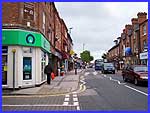 After
our visit to the D. H. Lawrence Birthplace Museum in Part 05,
we now return from Victoria Street to Nottingham Road (left)
and follow the Blue Line and Literary Trails again. The Blue
Line Trail runs along the northern side of Nottingham Road but
the plaques on the Literary Trail are on both sides so to see
them all involves passing back and forth across the busy road.
Pedestrian crossings at regular intervals make this a relatively
easy task but the constant flow of traffic made photography a
little more difficult and at times it was virtually impossible
to get a clear view across the road of a relevant feature. After
our visit to the D. H. Lawrence Birthplace Museum in Part 05,
we now return from Victoria Street to Nottingham Road (left)
and follow the Blue Line and Literary Trails again. The Blue
Line Trail runs along the northern side of Nottingham Road but
the plaques on the Literary Trail are on both sides so to see
them all involves passing back and forth across the busy road.
Pedestrian crossings at regular intervals make this a relatively
easy task but the constant flow of traffic made photography a
little more difficult and at times it was virtually impossible
to get a clear view across the road of a relevant feature.
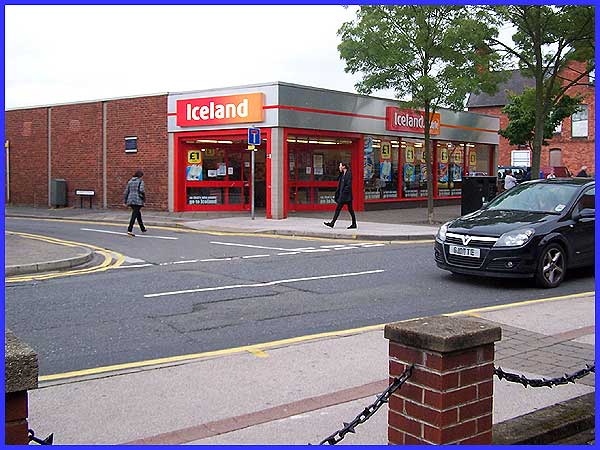
At the next road junction a short stub of the blue line leads
into Albert Street as far as the blue board on the wall of this
rather uninspiring building. A view from a similar position is
available at the Picture The Past site (click
here) shows a much grander structure that remained here until
demolition in 1971. That building was the Congregational Chapel
that the Lawrence family often attended. Behind the chapel was
the British School where Bert often went to 'penny readings'
and literary society meetings. Later between 1902 and 1905 he
spent 'three years savage teaching of collier lads.'
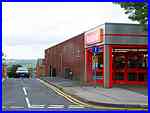
In the footpath below the board is the eighth literary plaque
and this one has a quotation from 'The Christening': "The
wide valley opened out from her, with the far woods withdrawing
into twilight, and away in the centre the great pit streaming
its white smoke and chuffing as the men were being turned up."
As can be seen from the small image on the right, there is still
a view across the valley but the pit has now disappeared.
Like the pit the chapel and school have also gone but there are
several pictures of them at Picture The Past:
Click to see the chapel circa 1920, in 1958, in 1966, the school in 1958 and a rear view from 1965.
|
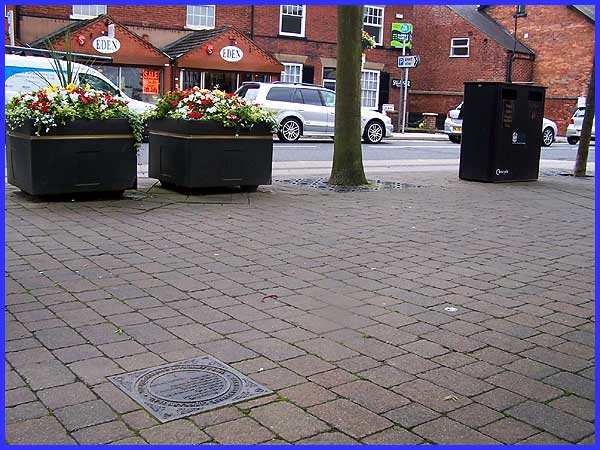
I have to admit that compared to the previous occupant of the
site, the architecture of the Iceland building leaves me, excuse
the pun, pretty cold but its frontage does contain the ninth
literary plaque and a quotation from Bert's 'Hymns in a Man's
Life': "I liked our chapel, which was tall and full of
light, and yet still; and colourwashed pale green and blue, with
a bit of a lotus pattern. And over the organ-loft, '0 worship
the Lord in the beauty of holiness', in big letters."
|
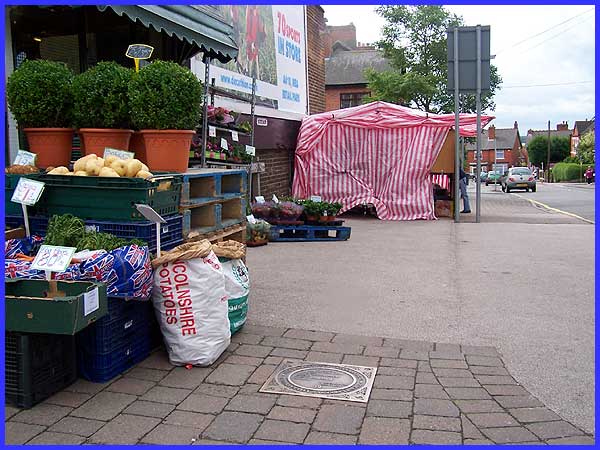
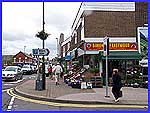 Eastwood
has done much to restore many parts of the town in the style
of D. H. Lawrence's time but many late twentieth century buildings
in the main shopping area pay little or no homage to the author.
The next plaque is on the south side of Nottingham Road at its
junction with Alexandra Street and is in the footpath of another
building of little architectural merit. The quotation from Bert's
'Nottingham and the Mining Country' reads: "Now Eastwood
occupies a lovely position on a hilltop, with the steep slope
towards Derbyshire and the long slope towards Nottingham." Eastwood
has done much to restore many parts of the town in the style
of D. H. Lawrence's time but many late twentieth century buildings
in the main shopping area pay little or no homage to the author.
The next plaque is on the south side of Nottingham Road at its
junction with Alexandra Street and is in the footpath of another
building of little architectural merit. The quotation from Bert's
'Nottingham and the Mining Country' reads: "Now Eastwood
occupies a lovely position on a hilltop, with the steep slope
towards Derbyshire and the long slope towards Nottingham."
|
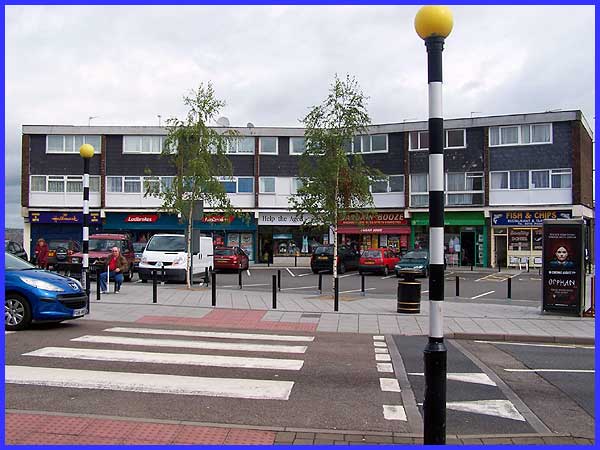
That "lovely position" is still the same but the centre
of the town has undergone some substantial redevelopment. Its
former appearance is recalled in the quotation on the eleventh
plaque seen here in the footpath back on the north side and outside
'The Hollies' - another functional rather than aesthetically
pleasing development. It again comes from 'Nottingham and the
Mining Country' and reads: "The string of coal-mines
of B. W. & Co had been opened some sixty years before I was
born and Eastwood had come into being as a consequence. It must
have been a tiny village at the beginning of the nineteenth century,
a small place of cottages..." .
|
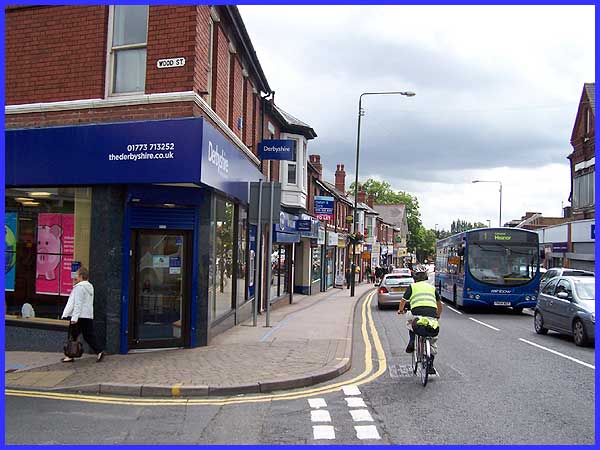
To the right of 'The Hollies' as seen in the previous image is
Wood Street and it is here that the Blue Line Trail splits. Our
route now is to follow the blue line down Wood Street and we
shall not see the remaining three literary plaques until we return
to this point along Nottingham Road from the opposite direction.
No doubt the traffic will still be as heavy but from here on
we shall be walking in a much quieter area.
|
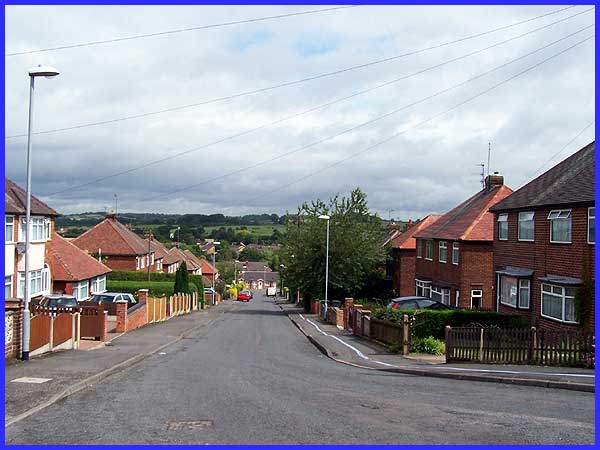
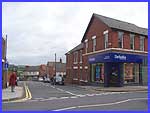 In Bert's time
Wood Street was less than a hundred yards long and the extent
of it can be seen in this small image. A post Second World War
development (above) saw many new houses built on the fields and
allotment gardens that separated Eastwood from the small settlements
of The Breach and Lower Beauvale. Both are now incorporated into
the town of Eastwood but would certainly have been part of Bert's
"country of my heart." The blue line that is clearly
visible in this image continues down Wood Street and zig-zags
via a footpath to reach the area formerly called The Breach and
it is there that we will resume the walk in Part 07. In Bert's time
Wood Street was less than a hundred yards long and the extent
of it can be seen in this small image. A post Second World War
development (above) saw many new houses built on the fields and
allotment gardens that separated Eastwood from the small settlements
of The Breach and Lower Beauvale. Both are now incorporated into
the town of Eastwood but would certainly have been part of Bert's
"country of my heart." The blue line that is clearly
visible in this image continues down Wood Street and zig-zags
via a footpath to reach the area formerly called The Breach and
it is there that we will resume the walk in Part 07.
|

